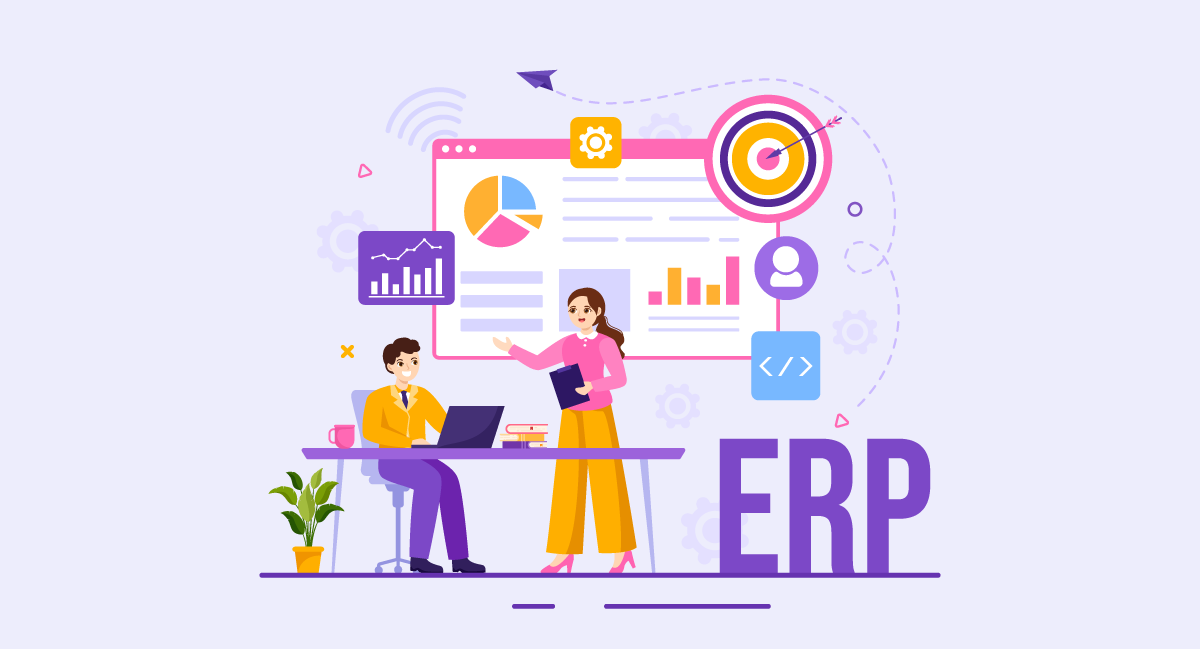Enterprise Resource Planning (ERP) systems have revolutionized the way businesses operate by providing integrated software solutions that streamline and optimize various aspects of their operations. These systems have found widespread adoption across industries, enabling organizations to efficiently manage their resources, enhance collaboration, and make data-driven decisions.
In this digital transformation era, ERP systems are crucial in helping businesses automate processes, improve productivity, and gain a competitive edge. ERP systems are crucial for digital transformation & provide a unified platform that facilitates seamless communication and data flow across departments by integrating functions such as finance, human resources, procurement, manufacturing, sales, and customer relationship management.
ERP System Examples for Different Industries
There are different enterprise resource planning systems available for different industries, and below we have curated a list of ERP system examples for you. You can check out the cloud based ERP system software examples based on your company’s requirements.
Pro-tip
When purchasing an ERP System, every company’s requirements are different. You need to adopt an ERP system based on your industry to get the most out of it. Such Industry-specific ERP systems are more effective than the ones targeted at a general audience.
ERP Tools Examples in Manufacturing Industry
1. Oracle ERP Cloud

Oracle ERP Cloud
2 Reviews
Oracle ERP Cloud is a comprehensive enterprise resource planning (ERP) system for manufacturing industry. It provides a suite of integrated applications and modules that assist in managing various aspects of manufacturing operations, such as supply chain management, procurement, inventory control, production planning, and financial management.
It offers a scalable and flexible solution that caters to the needs of small, medium, and large manufacturing organizations.
USP
Oracle ERP Cloud offers robust functionality, seamless integration with other Oracle Cloud applications, and the ability to deliver real-time insights for informed decision-making. It combines the power of ERP with cloud technology, allowing organizations to leverage scalability, security, and accessibility advantages.
Benefits
- Oracle ERP Cloud automates key manufacturing processes, reducing manual effort and improving productivity.
- The system provides real-time insights into inventory levels, production status, and financial performance, enabling better decision-making.
- Organizations can achieve cost savings by optimizing inventory, streamlining procurement, and minimizing production bottlenecks.
- Oracle ERP Cloud can accommodate the needs of growing manufacturing businesses, allowing for easy expansion and adaptation.
Challenges
- Implementing and customizing Oracle ERP Cloud can be complex and require specialized expertise.
- Organizations may face challenges in training employees to effectively use the system and ensuring widespread adoption.
- Integrating Oracle ERP Cloud with existing legacy systems can pose technical challenges.
Pricing
Oracle provides customized pricing plans.
2. QAD ERP
QAD ERP is a leading enterprise resource planning system designed specifically for the manufacturing industry. It provides a range of modules and functionalities to support various manufacturing operations, including supply chain management, production planning, inventory control, quality management, and financials. QAD ERP focuses on process efficiency, global manufacturing capabilities, and industry-specific features.
USP
QAD ERP stands out by offering a robust solution tailored to the needs of manufacturers. Its key USPs include its focus on process optimization, support for global manufacturing operations, and industry-specific features that address unique manufacturing requirements.
Benefits
- QAD ERP optimizes manufacturing processes, resulting in improved operational efficiency and reduced lead times.
- The system supports the complexities of global manufacturing, including multi-site, multi-language, and multi-currency capabilities.
- QAD ERP helps ensure compliance with industry regulations and facilitates effective quality management.
- The system provides real-time visibility into manufacturing operations, enabling data-driven decision-making.
Challenges
- Implementing QAD ERP may require significant time and resources, particularly for organizations with complex manufacturing processes.
- Some organizations may require customization to align the system with their specific manufacturing workflows.
- Training employees and managing the change associated with adopting a new ERP system can be challenging.
Pricing
Basic plan costs $250 per month per user.
ERP Application Examples in Retail Industry
1. Microsoft Dynamics 365

Microsoft Dynamics 365
9 Reviews
Microsoft Dynamics 365 is a comprehensive enterprise resource planning (ERP) system tailored for the retail industry. It offers a suite of integrated applications and modules that assist retailers in managing various aspects of their operations, including inventory management, sales and customer management, supply chain optimization, financials, and business intelligence. Microsoft Dynamics 365 provides a scalable and flexible solution suitable for small, medium, and large retail organizations.
USP
Microsoft Dynamics 365 has seamless integration with other Microsoft products and services, such as Office 365 and Power Platform. It combines ERP functionality with powerful collaboration tools, advanced analytics, and cloud capabilities, empowering retailers to streamline their operations and enhance customer experiences.
Benefits
- Microsoft Dynamics 365 helps retailers optimize inventory levels, reduce stockouts, and improve demand forecasting accuracy.
- The system enables retailers to manage sales across multiple channels, including online, in-store, and mobile, providing a seamless shopping experience.
- Microsoft Dynamics 365 offers robust customer management features, allowing retailers to enhance customer engagement, loyalty, and personalized experiences.
- Advanced analytics and business intelligence capabilities provide real-time insights into sales, inventory, and customer behavior, enabling informed decision-making.
Challenges
- Implementing and configuring Microsoft Dynamics 365 can be complex, requiring proper planning, expertise, and data migration.
- Retail employees may require training to effectively use the system, and organizations should focus on change management to ensure smooth adoption.
Pricing
Business Central essential plan starts at INR 5,495 per user per month.
2. SAP ERP
SAP ERP is a widely used enterprise resource planning system (ERP) software in the retail industry. It offers a comprehensive set of modules and functionalities to support retail operations, including inventory management, sales and distribution, procurement, financials, and analytics. SAP ERP provides a scalable and robust solution suitable for retailers of various sizes and complexities.
USP
SAP ERP differentiates itself through its extensive industry expertise and a broad range of integrated applications. It provides a flexible and customizable platform that can be tailored to meet the specific needs of retail organizations, enabling them to optimize operations, improve profitability, and enhance customer experiences.
Benefits
- SAP ERP integrates various retail processes, including merchandise planning, inventory management, pricing, and promotions, to streamline operations and improve efficiency.
- The system enables retailers to deliver personalized experiences, manage loyalty programs, and analyze customer preferences for targeted marketing and sales.
- SAP ERP helps retailers optimize their supply chain by enabling demand forecasting, improving procurement processes, and enhancing collaboration with suppliers.
- The system provides powerful analytics and reporting capabilities, enabling retailers to gain actionable insights into sales performance, inventory levels, and customer behavior.
Challenges
- Implementing SAP ERP can be complex, requiring careful planning, skilled resources, and data migration from legacy systems.
- Organizations may need to customize and configure SAP ERP to align with their specific retail processes and requirements.
- Successful implementation and ongoing support of SAP ERP may require dedicated resources, including trained personnel and IT infrastructure.
Pricing
SAP ERP provides custom pricing options.
Examples of ERP Software in Healthcare Industry
1. Acumatica
.png)
Acumatica is an enterprise resource planning (ERP) system for the healthcare industry. It offers a comprehensive set of integrated applications and modules that cater to the specific needs of healthcare organizations, including hospitals, clinics, and medical facilities.
Acumatica provides functionalities for managing patient records, medical billing, inventory control, scheduling, financial management, and compliance with healthcare regulations.
USP
Acumatica comes with flexible deployment options, including on-premises, cloud, and hybrid models. It provides healthcare organizations with the freedom to choose the deployment method that best suits their needs, while offering a user-friendly interface, robust functionality, and scalability.
Benefits
- Acumatica enables healthcare providers to efficiently manage patient records, appointments, and medical history, ensuring accurate and accessible information.
- The system streamlines billing processes, automates claims management, and optimizes revenue cycle workflows for improved financial performance.
- Acumatica facilitates inventory management, ensuring the availability of medical supplies and reducing stockouts or excess inventory.
- The ERP system helps healthcare organizations adhere to healthcare regulations, such as HIPAA, by implementing security measures and providing audit trails.
Challenges
- Implementing Acumatica in healthcare organizations may require careful planning, data migration, and customization to align with specific workflows and compliance requirements.
- Healthcare staff may require training to effectively utilize the system, and organizations should focus on change management to ensure smooth adoption.
Pricing
The pricing plan starts from $1400 per month.
2. ERPNext

ERPNext is an open-source enterprise resource planning system suitable for healthcare organizations. It offers a range of modules and functionalities to support various aspects of healthcare operations, including patient management, appointment scheduling, medical billing, inventory control, and accounting. ERPNext focuses on providing a cost-effective solution with customizable features.
USP
ERPNext differentiates itself by being an open-source ERP system, allowing healthcare organizations to have access to the source code and customize the system according to their specific requirements. It offers an affordable option for healthcare organizations seeking flexibility and control over their ERP solution.
Benefits
- ERPNext helps healthcare providers manage patient information, appointments, and medical records in a centralized and organized manner.
- The system supports medical billing processes, automates invoicing, tracks payments, and manages accounting functions.
- ERPNext facilitates inventory management, ensuring the availability of medical supplies and optimizing procurement processes.
- ERPNext provides a cost-effective option for healthcare organizations, reducing licensing costs and offering customization possibilities.
Challenges
- Implementing and customizing ERPNext may require technical expertise or external support to align the system with specific healthcare workflows and requirements.
- Support options may be limited compared to proprietary ERP solutions, and organizations may rely on the community or external partners for assistance.
Pricing
The pricing plan starts at INR 820 per site per month.
ERP System Examples in Financial Services Industry
1. Tally.ERP 9
.png)
Tally.ERP 9 is an enterprise resource planning (ERP) system specifically designed for the financial services industry. It offers a comprehensive suite of applications and modules to manage various financial operations, including accounting, financial reporting, taxation, inventory management, and payroll. Tally.ERP 9 provides a user-friendly interface and robust functionality that caters to the specific requirements of financial service providers.
USP
Tally.ERP 9 ERP software for financial services offers simplicity, ease of use, and wide acceptance among financial service professionals. It offers a powerful and efficient solution to manage and streamline business processes while providing flexibility to adapt to evolving business needs.
Benefits
- Tally.ERP 9 streamlines financial operations, including ledger management, banking transactions, invoicing, and financial reporting, ensuring accuracy and compliance.
- The system helps financial service providers comply with tax regulations by automating tax calculations, generating tax reports, and facilitating tax filing processes.
- Tally.ERP 9 allows tracking and managing inventory, enabling efficient stock management and reducing inventory-related costs.
- The system automates payroll processes, including salary calculations, deductions, and tax withholdings, ensuring accurate and timely payroll processing.
Challenges
- Organizations may require customization and configuration to align Tally.ERP 9 with their specific financial workflows and reporting requirements.
- Integrating Tally.ERP 9 with other systems, such as banking software or customer relationship management (CRM) tools, may require technical expertise and effort.
Pricing
- Silver plan – INR 18,000
- Gold plan – INR 54,000
2. Marg ERP 9+

Marg ERP 9+ is an enterprise resource planning (ERP) system designed for the financial services industry. It offers comprehensive modules and functionalities to manage financial operations, inventory control, billing, taxation, and compliance. Marg ERP 9+ focuses on providing a feature-rich and scalable solution for financial service providers.
USP
Marg ERP 9+ differentiates itself by offering industry-specific features and a flexible platform that caters to the unique needs of financial service providers. It provides advanced capabilities to streamline operations, enhance efficiency, and improve customer service.
Benefits
- Marg ERP 9+ enables efficient financial management, including ledger management, expense tracking, bank reconciliation, and financial reporting.
- The system helps financial service providers manage inventory, track stock levels, automate reordering, and optimize inventory costs.
- Marg ERP 9+ facilitates tax compliance by automating tax calculations, generating tax reports, and assisting with tax filing processes.
- The system offers features to manage customer information, track interactions, and provide personalized services to enhance customer relationships.
Challenges
- Implementing and configuring Marg ERP 9+ may require proper planning, data migration, and customization to align with specific financial workflows and compliance requirements.
- Organizations may need to provide training to employees to effectively utilize the system and ensure smooth adoption.
Pricing
The basic edition starts at INR 8991.
Enterprise Resource Planning Example in Education Industry
1. Teachmint

Teachmint is an enterprise resource planning (ERP) platform for the education industry. It offers comprehensive tools and features to support online teaching, classroom management, student engagement, and administrative tasks. Teachmint aims to simplify and streamline the operations of educational institutions by providing a user-friendly platform for online classes, attendance management, content sharing, and student assessments.
USP
Teachmint differentiates itself through its focus on online teaching and learning. It provides a seamless virtual classroom experience and features that enable efficient administration and collaboration between teachers, students, and parents.
Benefits
- Teachmint offers a robust platform for conducting live online classes, facilitating real-time interaction, screen sharing, and content sharing between teachers and students.
- The system simplifies attendance tracking, student data management, and performance monitoring, providing insights for better student engagement and personalized learning.
- Teachmint enables teachers to share study materials, assignments, and assessments digitally, streamlining the learning process and providing instant feedback to students.
- The platform facilitates seamless communication and collaboration between teachers, students, and parents, allowing for effective engagement and regular updates.
Challenges
- Users of Teachmint may need to ensure they have reliable internet connectivity and access to devices that meet the system requirements for a smooth online teaching and learning experience.
- Teachers and administrators may require training and support to effectively utilize the features and functionalities of Teachmint.
Pricing
The platform provides custom pricing,
2. OpenEduCat

OpenEduCat
OpenEduCat is an open-source enterprise resource planning (ERP) system designed specifically for educational institutions. It provides a comprehensive suite of modules and functionalities to manage various aspects of education, including student information management, course management, admissions, examinations, finance, and human resources.
OpenEduCat focuses on delivering a flexible and customizable solution that caters to the specific needs of educational organizations.
USP
OpenEduCat stands out in the market because of its open-source nature, allowing educational institutions to access and modify the source code to meet their specific requirements. It provides a cost-effective and adaptable ERP solution for educational institutions seeking flexibility and control over their system.
Benefits
- OpenEduCat enables efficient management of student data, including admissions, enrollment, attendance, grades, and academic progress.
- The system assists in managing courses, scheduling classes, creating lesson plans, and tracking curriculum alignment to ensure a well-structured education program.
- OpenEduCat helps educational institutions manage their finances, including fee collection, budgeting, expense tracking, and generating financial reports.
- Being an open-source ERP system, OpenEduCat allows institutions to customize and extend its functionality based on their unique requirements, ensuring scalability and adaptability.
Challenges
- Implementing and customizing OpenEduCat may require technical expertise or external support to align the system with specific educational workflows and reporting requirements.
- Support options for OpenEduCat may rely on the community or external partners, and organizations may need to ensure access to adequate support channels.
Pricing
The platform provides customized pricing.
ERP System Examples in Hospitality Industry
1. Deskera

Deskera is an enterprise resource planning (ERP) system designed specifically for the hospitality industry. It provides a comprehensive suite of applications and modules that cater to the unique needs of hotels, restaurants, resorts, and other hospitality businesses. Deskera offers functionalities for managing reservations, guest services, inventory, point of sale (POS), accounting, and human resources.
USP
Deskera differentiates itself by offering an all-in-one ERP solution specifically tailored for the hospitality industry. It provides a seamless and integrated platform that enhances operational efficiency, improves guest experiences, and enables better financial management for hospitality businesses.
Benefits
- Deskera enables efficient management of reservations and booking management, including online reservations, room assignment, availability tracking, and automated check-in/check-out processes.
- The system helps hospitality businesses deliver exceptional guest experiences by managing guest preferences, requests, loyalty programs, and personalized services.
- Deskera facilitates inventory management for restaurants, bars, and other hospitality establishments, optimizing stock levels, managing suppliers, and tracking costs.
- The ERP system streamlines financial processes, including billing, invoicing, accounts receivable, and financial reporting, providing insights for better financial decision-making.
Challenges
- Implementation and Configuration: Implementing and configuring Deskera may require proper planning, data migration, and customization to align with specific hospitality workflows and reporting requirements.
- Training and Adoption: Hospitality staff may require training to effectively utilize the system, and organizations should focus on change management to ensure smooth adoption.
Pricing
The pricing plan starts at INR 2,900.
2. Sage

Sage is an enterprise resource planning (ERP) system widely used in the hospitality industry. It provides a comprehensive suite of modules and functionalities to support various aspects of hospitality operations, including reservations, front desk management, inventory control, point of sale (POS), financials, and reporting. Sage ERP software for Hospitality industry offers a flexible and scalable solution suitable for hotels, resorts, and other hospitality establishments.
USP
Sage differentiates itself through its extensive industry experience and a wide range of integrated applications. It provides a robust and customizable platform that can be tailored to meet the specific needs of hospitality businesses, enabling them to optimize operations, enhance guest satisfaction, and achieve better financial management.
Benefits
- Sage facilitates efficient reservation management, room assignments, check-in/check-out processes, and guest services to ensure a smooth and seamless guest experience.
- The system helps hospitality businesses manage inventory for food and beverage, supplies, and other operational needs, optimizing stock levels, reducing waste, and controlling costs.
- Sage offers a comprehensive POS solution that integrates with other modules, allowing seamless order processing, billing, and payment management.
- Sage streamlines financial processes, including accounting, billing, invoicing, accounts receivable, and reporting, providing insights for better financial decision-making.
Challenges
- Implementing Sage in hospitality businesses may require careful planning, data migration, and customization to align with specific workflows and reporting requirements.
- Organizations may need ongoing support to ensure smooth operations and address any technical issues.
Pricing
The pricing plan starts at $10.
ERP System Examples in Logistics Industry
1. Epicor

Epicor is an enterprise resource planning (ERP) system that caters to the logistics industry. It offers a comprehensive suite of modules and functionalities designed to streamline and optimize logistics operations. Epicor provides features for managing inventory, warehouse operations, transportation, order management, and supply chain planning, along with financial and accounting capabilities.
USP
Epicor differentiates itself through its industry-specific functionality and focuses on delivering end-to-end solutions for the logistics sector. It offers robust tools that enable logistics businesses to improve operational efficiency, enhance customer service, and drive profitability.
Benefits
- Epicor allows logistics companies to manage their inventory effectively, optimize stock levels, reduce carrying costs, and improve order fulfillment.
- The system streamlines warehouse processes, including receiving, picking, packing, and shipping, enhancing overall efficiency and reducing errors.
- Epicor provides tools for managing transportation activities, such as route optimization, carrier selection, tracking, and freight cost management.
- The ERP system enables efficient order processing, tracking, and customer service, ensuring timely delivery and customer satisfaction.
Challenges
- Implementing Epicor in logistics companies may require careful planning, data migration, and customization to align with specific workflows and industry requirements.
- Logistics staff may require training to effectively utilize the system, and organizations should focus on change management to ensure a smooth transition.
Pricing
The platform provides custom pricing.
2. Ramco ERP

Ramco ERP is an enterprise resource planning system designed for the logistics industry. It provides a comprehensive set of modules and functionalities to support logistics operations, including supply chain management, fleet management, warehouse management, freight forwarding, and customs compliance. Ramco ERP focuses on delivering a cloud-based, mobile-friendly solution for logistics businesses.
USP
Ramco ERP differentiates itself through its cloud-based architecture and mobile accessibility. It offers a user-friendly interface, advanced analytics, and real-time visibility into logistics operations, empowering businesses to make data-driven decisions, improve efficiency, and enhance customer service.
Benefits
- Ramco ERP facilitates end-to-end supply chain visibility, enabling efficient demand planning, procurement, order management, and inventory control.
- The system supports fleet scheduling, route optimization, maintenance tracking, fuel management, and driver performance monitoring, optimizing fleet operations.
- Ramco ERP provides tools for managing warehouse activities, including inventory tracking, space optimization, order fulfillment, and warehouse performance analytics.
- The ERP system assists in managing customs documentation, compliance, and duty calculations, ensuring smooth international trade operations.
Challenges
- Implementing and customizing Ramco ERP may require careful configuration to align with specific logistics workflows, compliance requirements, and integration with external systems.
- Logistics staff may require training to effectively utilize the system, and ongoing support may be necessary to address any technical issues or system updates.
Pricing
Ramco ERP is priced at $80.
ERP Software Examples in Professional Services Industry
1. Infor

Infor is an enterprise resource planning (ERP) software solution designed for the professional services industry. It offers a range of modules and functionalities tailored to meet the specific needs of professional services firms, including project management, resource planning, time tracking, billing, and financial management. Infor aims to improve operational efficiency, enhance project delivery, and enable better financial control for professional services organizations.
USP
Infor differentiates itself through its industry-specific features and deep understanding of the professional services sector. It provides a comprehensive solution that addresses the unique challenges and requirements of professional services firms, allowing them to optimize resource utilization, streamline project management, and improve profitability.
Benefits
- Infor helps professional services firms effectively manage their projects, including project planning, task allocation, milestone tracking, and collaboration among team members.
- The ERP system enables organizations to efficiently allocate and manage resources, ensuring optimal utilization of skills, availability, and capacity.
- Infor offers features for tracking employee time spent on projects, automating the billing process, and generating accurate invoices based on project activities and billable hours.
- The software provides financial modules that facilitate budgeting, expense tracking, revenue recognition, and financial reporting, helping organizations gain better financial control and visibility.
Challenges
- Implementing Infor may require careful planning and configuration to align with specific professional services workflows, integrate with existing systems, and migrate data effectively.
- Professional services staff may require training to effectively utilize the system and embrace new processes and workflows.
Pricing
The platform provides custom quote.
2. Scoro

Scoro is an enterprise resource planning (ERP) software solution designed for professional services firms. It offers a comprehensive suite of modules and functionalities to support project management, collaboration, time tracking, billing, financial management, and reporting. Scoro aims to streamline operations, improve productivity, and enhance profitability for professional services organizations.
USP
Scoro differentiates itself through its user-friendly interface, extensive project management capabilities, and the integration of various business functions into a single platform. It provides a holistic solution that enables professional services firms to manage projects, resources, time, finances, and customer relationships seamlessly.
Benefits
- Scoro offers robust project management features, including project planning, task management, collaboration, document management, and progress tracking, ensuring efficient project execution.
- The software helps organizations effectively allocate and schedule resources, manage team availability, and monitor resource utilization to ensure optimal resource allocation and avoid bottlenecks.
- Scoro provides tools for tracking time spent on projects, generating accurate invoices based on billable hours, and streamlining the billing process to ensure timely and accurate invoicing.
- Scoro offers financial modules for budgeting, expense tracking, revenue recognition, profitability analysis, and financial reporting, providing insights for better financial control and decision-making.
Challenges
- Implementing and customizing Scoro may require configuration to align with specific professional services workflows, reporting requirements, and integration with other systems.
- Professional services staff may require training to effectively utilize the system and adapt to new processes and workflows.
Pricing
- Essential plan – $26 per user per month
- Standard plan – $37 per user per month
- Pro plan – $63 per user per month
- Ultimate plan – custom pricing
ERP Examples in Government Sector
1. Opengov

Opengov
OpenGov is an advanced & intuitive enterprise resource planning (ERP) software for government agencies. It provides a comprehensive suite of modules and functionalities to help government organizations manage their financials, budgeting, procurement, human resources, and reporting. OpenGov aims to improve transparency, streamline processes, and enhance decision-making for government agencies.
USP
OpenGov differentiates itself through its focus on the unique needs of the government sector. It offers a user-friendly, cloud-based solution that enables governments to consolidate and automate their financial and administrative processes, enhance collaboration, and provide citizens with transparent access to information.
Benefits
- OpenGov facilitates effective financial management, including budgeting, accounting, grant management, and financial reporting, helping government organizations ensure fiscal responsibility and transparency.
- The ERP system streamlines procurement processes, from requisitions to vendor management and contract tracking, enabling efficient procurement operations and ensuring compliance.
- OpenGov provides modules for managing employee information, payroll, benefits, time and attendance, and workforce planning, supporting efficient human resources operations in government agencies.
- The software offers robust reporting and analytics capabilities, allowing government organizations to generate insightful reports and provide transparent financial and performance information to stakeholders.
Challenges
- Implementing OpenGov in government agencies may require careful planning, data migration, and configuration to align with specific government workflows and compliance requirements. Ensuring user adoption and change management can also be a challenge.
- Government organizations need to ensure the security and privacy of sensitive data. Proper measures should be taken to protect data from unauthorized access and maintain compliance with regulatory standards.
Pricing
OpeenGov provides custom pricing.
2. Deltek
Deltek is an enterprise resource planning (ERP) software solution widely used in the government sector. It offers a comprehensive suite of modules and functionalities to support project management, financial management, procurement, human resources, and reporting for government agencies. Deltek aims to improve project execution, financial control, and resource management for government organizations.
USP
Deltek differentiates itself through its deep industry expertise and specialized solutions tailored to the needs of government agencies. It provides a scalable and configurable platform that helps government organizations streamline their operations, achieve compliance, and enhance project and financial management.
Benefits
- Deltek offers robust project management features, including project planning, scheduling, resource allocation, task tracking, and collaboration, helping government agencies deliver projects on time and within budget.
- The ERP system provides financial modules for budgeting, accounting, procurement, contract management, and financial reporting, enabling better financial control and transparency in government organizations.
- Deltek facilitates procurement processes, from requisition to payment, and offers contract management functionalities, ensuring compliance, cost control, and efficient vendor management.
- The software includes human resources modules for managing employee information, payroll, benefits, time and attendance, and workforce planning, supporting effective human resources operations in government agencies.
Challenges
- Implementing and customizing Deltek for government organizations may require configuration to align with specific workflows, regulatory requirements, and integration with other systems.
- Government agencies need to ensure the security and confidentiality of sensitive data. Deltek should be implemented with proper security measures to protect data and comply with regulatory standards.
Pricing
Front office suite starts at $30 per employee.
ERP System Examples in Nonprofit Organizations
1. Blackbaud

Blackbaud
Blackbaud is an enterprise resource planning (ERP) system for nonprofit with robust features and functionalities. It provides a comprehensive suite of modules and functionalities to support fundraising, donor management, financial management, marketing, event management, and constituent relationship management. Blackbaud aims to help nonprofits streamline their business operations, improve fundraising effectiveness, and enhance constituent engagement.
USP
Blackbaud differentiates itself through its deep understanding of the nonprofit sector and its focus on providing tailored solutions for nonprofit organizations. It offers a range of specialized tools and features to help nonprofits achieve their fundraising goals, manage donor relationships, and drive mission success.
Benefits
- Blackbaud offers advanced fundraising tools, including donor tracking, gift processing, campaign management, and online fundraising capabilities, enabling nonprofits to effectively manage their fundraising efforts.
- The ERP system provides features for donor segmentation, cultivation, and stewardship, helping nonprofits build and maintain strong relationships with their supporters.
- Blackbaud includes modules for budgeting, accounting, grant management, and financial reporting, assisting nonprofits in maintaining financial transparency and accountability.
- The software offers marketing and communication tools to engage constituents, manage memberships, and organize events, enhancing outreach and involvement in nonprofit initiatives.
Challenges
- Implementing Blackbaud in nonprofit organizations may require careful planning, data migration, and configuration to align with specific nonprofit workflows and requirements. Staff training and change management are essential to ensure successful adoption of the system.
- Nonprofit organizations with unique workflows or specific requirements may face challenges in customizing the system to their specific needs. It is important to assess the flexibility and adaptability of the system during the evaluation process.
Pricing
Starter plan costs $6,000 per year.
2. Multiviewcorp

Multiview Corp is an enterprise resource planning (ERP) software solution designed for nonprofit organizations. It provides a range of modules and functionalities to support financial management, grant management, budgeting, project tracking, and reporting. Multiview Corp aims to help nonprofits improve financial control, streamline operations, and enhance transparency.
USP
Multiview Corp differentiates itself through its focus on financial management and reporting capabilities for nonprofit organizations. It provides comprehensive financial modules designed to meet the specific needs of nonprofits, allowing them to track funds, manage grants, and generate accurate financial reports.
Benefits
- Multiview Corp offers robust financial modules, including general ledger, accounts payable, accounts receivable, budgeting, and financial reporting, ensuring accurate financial tracking and compliance.
- The ERP system facilitates grant tracking, expense allocation, and compliance management, enabling nonprofits to effectively manage their grant-funded projects.
- Multiview Corp provides tools for budget creation, monitoring, and variance analysis, helping nonprofits effectively plan and manage their financial resources.
- The software offers reporting and analytics features to generate meaningful financial reports, track key performance indicators, and provide stakeholders with insights into the financial health of the organization.
Challenges
- Implementing Multiview Corp in nonprofit organizations may require careful configuration to align with specific financial and reporting requirements. Adequate planning and data migration strategies are essential for a successful implementation.
- Nonprofit staff may require training to effectively utilize the system and adapt to new financial processes.
Pricing
The pricing starts at $150 per user per year.
Final Thoughts
In conclusion, the examples of cloud based ERP systems in various industries demonstrate the versatility and effectiveness of these software solutions in addressing industry-specific challenges and streamlining operations.
ERP systems have become indispensable tools for organizations across industries, empowering them to streamline their operations, improve efficiency, and achieve their business goals effectively.

Supriya is a highly skilled content writer with over 8 years of experience in the SaaS domain. She believes in curating engaging, informative, and SEO-friendly content to simplify highly technical concepts. With an expansive portfolio of long-format blogs, newsletters, whitepapers, and case studies, Supriya is dedicated to staying in touch with emerging SaaS trends to produce relevant and reliable content.
Need Any Technology Assistance? Call Pursho @ 0731-6725516





